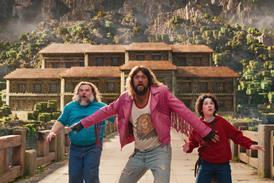Turner nominated artists The Wilson sisters, Louise Wilson and Jane Wilson, have been in Rotterdam this weekend for the international premiere of their new piece Undead Sun, originally presented in London’s Imperial War Museum last year.
Undead Sun sees the Newcastle-born sisters investigating the uses of disguise and camouflage in war. They regard the film as a natural successor to their 2011 work, Face Scripting: What Did the Building See. This was about the assassination of Hamas commander Mahmoud Al-Mabhouh by Mossad agents in a Dubai hotel.
“It was looking at CCTV and looking at covert imagery,” Jane Wilson says of a film which explores how contemporary warfare has moved from old fashioned battlefields into the luxurious confines of a modern, upmarket hotel. “What we were thinking about was how technology has developed through facial recognition and through use of CCTV.”
When the First World War started, the sisters note, there were still soldiers on horseback. By 1918, there were tanks, aerial warfare and surveillance - and early precursors of today’s “drone” technology. In Undead Sun, the sisters explore the use of “dazzle” camouflage, which was used in the First World War to confuse enemy ships - but modern variations are used to get round CCTV surveillance.
Jane Wilson points out that uses of decoys and simulation - common techniques in warfare - are part of an artist’s “dialogue” too.
The Wilsons’ work often deals with dark, disturbing subject matter drawn from recent historical events. For their 2011 piece The Toxic Camera (which also screened at Rotterdam in 2013), they explored the story behind a documentary made by Soviet filmmaker Vladimir Shevchenko on the Chernobyl disaster. Shevchenko was filming in Chernobyl immediately after the nuclear accident of 1986 and the camera he used became so toxic and radioactive that it had to be buried. The sisters visited Chernobyl themselves as part of their preparation.
“What was very moving was to encounter what was there now,” Louise Wilson says. Wary of “dark tourism,” they didn’t film there themselves but interviewed people involved in the clean up. They also spoke with Shevchenko’s crew members. The Soviet filmmaker died eight months after the incident as a result of radiation poisoning. What fascinated the sisters was the fact Shevchenko had somehow managed to “film” radiation.
“He had actually captured the impact of radiation on celluloid,” Jane Wilson reflects. “It had never been captured before and it could never be captured on digital formatting. It could only really be captured on analogue, on celluloid. The gamma rays were going through the body of the camera. This was what was fogging the film.”
At first, Shevchenko and his crew thought they had blundered with their camerawork. They soon realised, though, that they had been filming radiation.
The sisters are now hard at work on their current project, History Is Now: Seven Artists Take On Britain. This is a new show at London’s Hayward Gallery (due to open on February 10th) that they are co-curating. The idea behind the exhibition is to look at the cultural history of the UK over the last 50 years in advance of this year’s General Election in Britain. John Akomfrah, Simon Fujiwara, Roger Hiorns, Hannah Starkey, Richard Wentworth are the other artists curating.
“It is a reflection of British art and Britishness,” says Louise Wilson. She and her sister are focusing on work from the 1970s and 1980s. They will be showing work from Conrad Atkinson focusing on the “Troubles” in Northern Ireland and work from Penny Slinger. They are drawing on the Greenham Common archive.
Intriguingly, they are also including an image from the Stanley Kubrick archive. The sisters researched materials in the Kubrick archive extensively when they were preparing their 2009 installation, Unfolding the Aryan Papers. The installation was inspired by Kubrick’s unmade Holocaust movie The Aryan Papers, an adaptation of Louis Begley’s semi-autobiographical novel Wartime Lines.
The film was to have starred this year’s IFFR Jury member, Dutch actress Johanna ter Steege, but was abandoned, partly because the film would have come out at the same time as Steven Spielberg’s Schindler’s List. Box office for Kubrick’s earlier Vietnam war-themed feature Full Metal Jacket had been affected because the film appeared after Oliver Stone’s Platoon. Kubrick was worried that the audience wouldn’t accept two Holocaust films at the same time - and he may also have had misgivings about the very fact of making a Holocaust movie.
In his preparation for The Aryan Papers, Kubrick had acquired an archive of photos and materials from Ealing Studios. This was to help him recreate that architecture of pre-war and post-war Europe.
The image from the Kubrick archive the sisters are using in an old wartime photograph of a man acting as a human yardstick measure.
Jane and Louise have been working together since childhood. Many critics have pointed to their near telepathic rapport with one another “We were always painting, drawing or creating together,” says Louise. “We spent a lot of time at our grandmother’s house. She didn’t have a TV. I think we were really encouraged to create - draw, paint and make our own entertainment. When we went to separate art colleges, we found we were working on the same work almost.”

























No comments yet